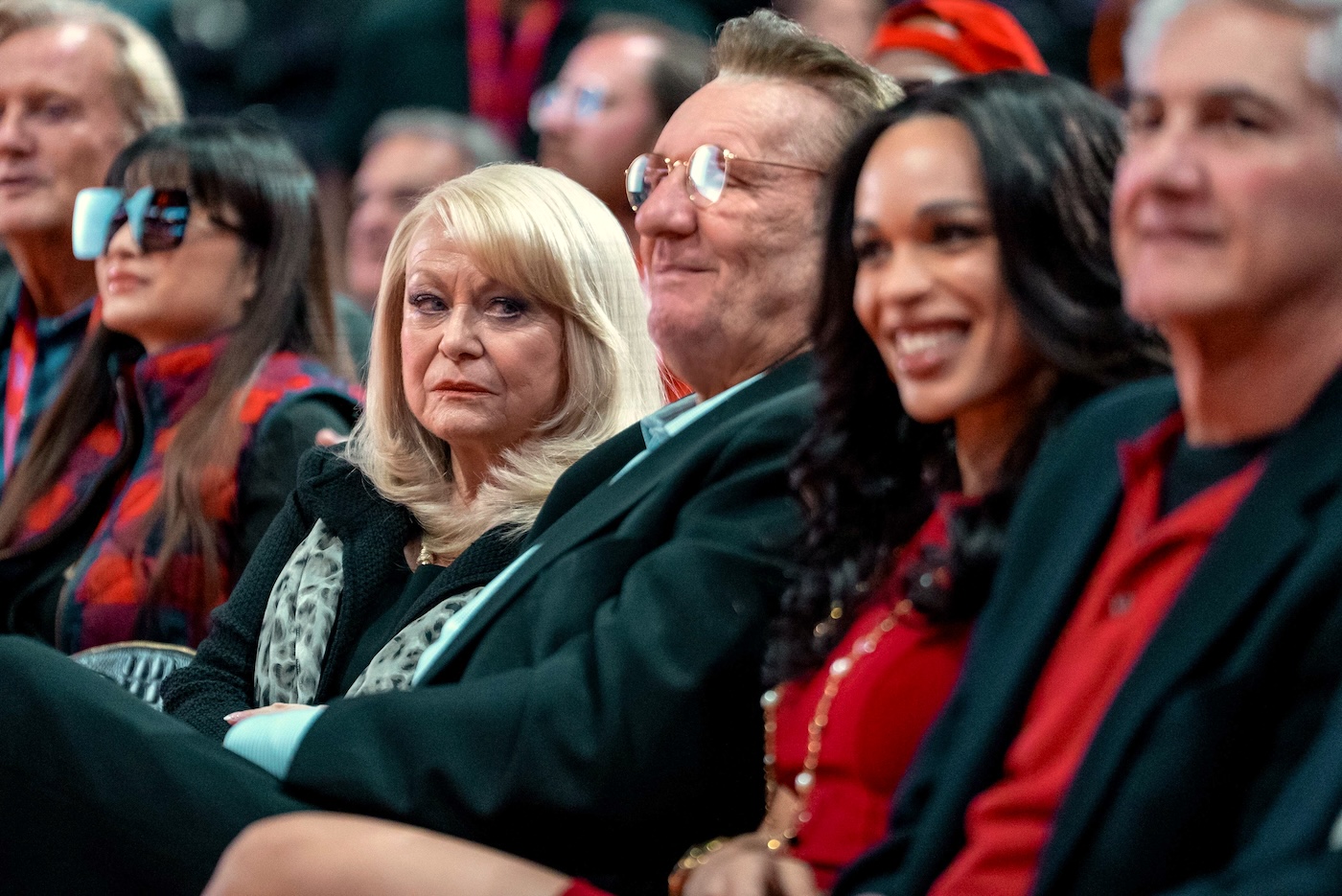FX’s new series about “that other L.A. basketball team” takes a fly-on-the-wall approach to visualize one of the first scandals of the Internet age.
by David Geffner / Photos by Kelsey McNeal/FX
There’s a moment in Clipped, the new dramatic limited series from FX (streaming exclusively on Hulu), where Shelly Sterling (Jacki Weaver) sits in her car outside her Malibu mansion listening to a recorded argument between her husband, Donald Sterling (Ed O’Neill) and his executive assistant, V. Stiviano (Cleopatra Coleman). The camera gazes patiently through the windshield at Shelly, who is obscured by reflections of lilting palm trees. While the world outside is L.A.-glam, the pain and embarrassment radiating from inside the car make it clear there’s trouble in paradise.
This simple, static shot from Episode 2, directed by Kevin Bray (who also was an executive producer) and lensed by Local 600 Director of Photography Bryce Fortner (A Million Little Things, Portlandia), is a visual punctuation of not only a marriage careening wildly off the tracks – thanks to Donald Sterling’s very public adoration for Stiviano – but also a hint that the empire Shelly has spent four decades building with her husband may soon collapse. The scene also marks the beginning of a narrative and visual shift from what has been mainly focused on a nasty domestic triangle to an impending racism scandal that will touch every corner of American culture.
“In our first conversation,” Fortner recounts, “[Showrunner/Executive Producer] Gina Welch showed me a book of photography by Larry Sultan, whose work she said mine was similar to. I had never heard of Larry Sultan, so I did a deep dive – his most famous series documented the everyday life of his parents – and was blown away. The way he used light was unique; and the framing, while observational, had a ton of emotion. That was what we were going for in this series. We wanted images that were simple and restrained, that didn’t force or manipulate the viewer – all of which fits my approach to cinematography.”
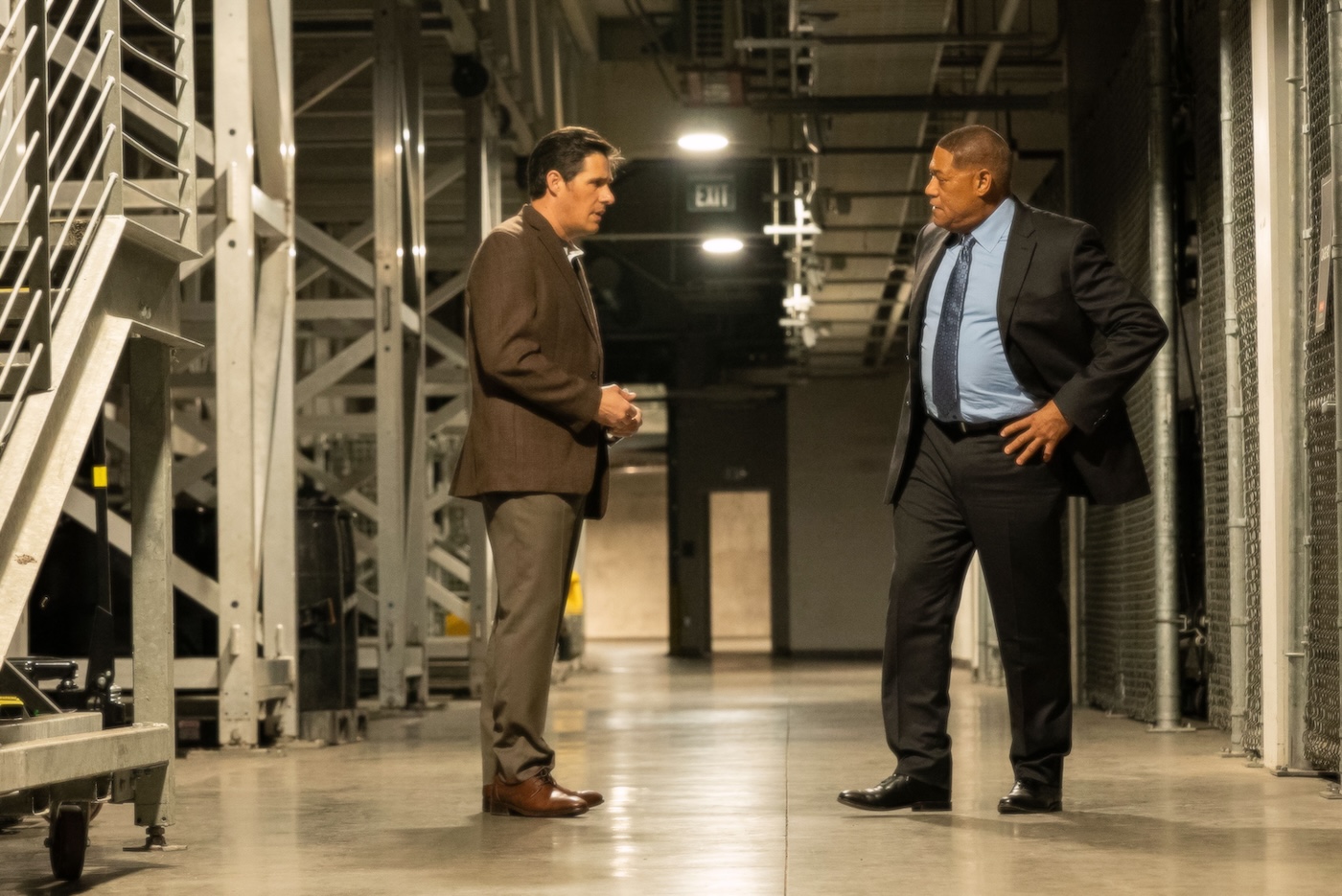
Sultan’s photographs were also key when Welch was writing the series. She says the way they portray Southern California “as this paradise that can also feel like hell felt relevant to the attitude of the show,” Welch adds. “Even before Bryce came on, my conversations with Kevin Bray were about paparazzi photos, and how we would be spying on scenes we shouldn’t be given access to.” Bray says he also drew from the work of [U.K. Photographer] Alison Jackson, “who does these celebrity look-alike recreations as seen from the perspective of a paparazzo, like when Jack Nicholson smashed the windshield of that guy’s car with a golf club [in 1994],” the veteran TV director explains. “Portraying scenes in this way provides an immediate association to something that we’re seeing in a historical context.”
Welch says she and Bray “looked at Ingrid Goes West [a 2017 Sundance hit shot by Fortner], and what stood out was how much Bryce was able to achieve with practical lighting. Nothing in that film felt staged – at all,” she states. “When Bryce and I met, we talked about 1970s cinema, particularly the film Klute [shot by Gordon Willis, ASC], and we geeked out over Larry Sultan’s work.”
The goal, according to Welch, was always to accomplish as much as possible in the wide shot. “I would sit in Video Village,” she continues, “and look at Bryce’s wide shots, and think: ‘You can hang these on a wall.’ His emphasis on practical lighting gives faces dynamism.” Welch references a photograph by Sultan “of his mother serving a turkey on Thanksgiving,” she continues. “Her hands, with the turkey on a tray, are sticking out into the sunlight, but her face and body are submerged in shadow. We talked about that approach and how the cinematography [Fortner shot Episodes 1, 2, 4, and 6; Jonathan Furmanski shot Episodes 3 and 5; and Jason Oldak handled the basketball/arena footage] could play with light and shadow to imbue these characters, some of whom are fairly absurd, with complexity.”

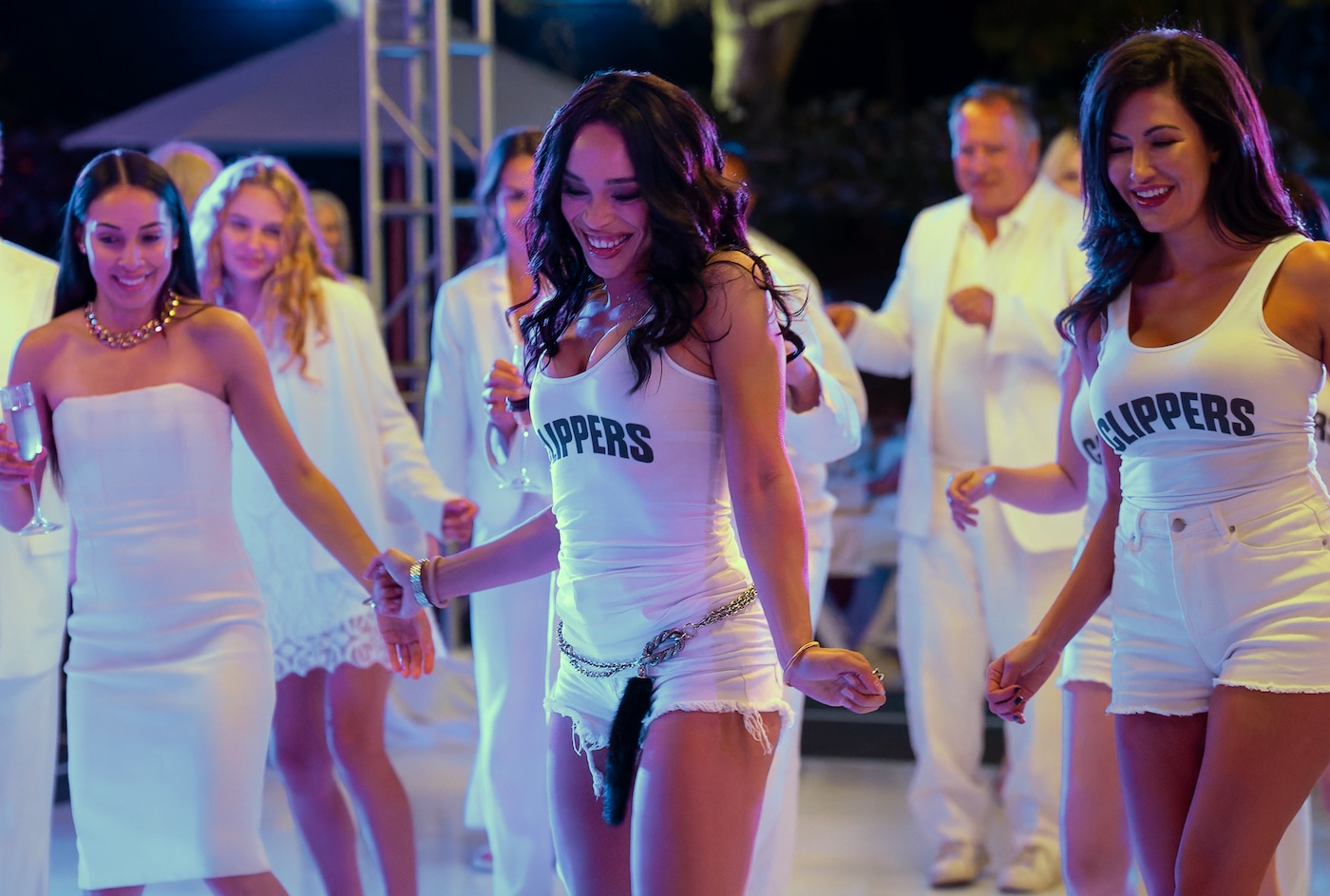
Visual complexity arrives early in the pilot episode with the IATSE production team tasked with reproducing Donald Sterling’s notorious “White Party.” Set in the backyard of the Malibu mansion, overlooking the Pacific Ocean, the party, which begins in the early afternoon and goes into the night, introduces newly hired coach Doc Rivers (Laurence Fishburne) to many of the Clippers’ star players – Chris Paul (J. Alphonse Nicholson), Blake Griffin (Austin Scott) and DeAndre Jordan (Sheldon Bailey), as well as highlighting the tension between Shelly and V., the latter of whom arrives (and departs with Donald to his other house in Beverly Hills!) in a blazing red Ferrari. Fortner admits that “on paper, this long day-into-night scene was intimidating. You’ve got a crowd of people wearing white clothes, white tablecloths, white floors – and a beige house. I thought: ‘How is this not going to look cheap?’ Then I watched footage of the real ‘White Party,’ and I felt better because it was completely low-fi! They had one little ‘Go Clippers’ banner strung up, and cheap party-rental color lights.” Fortner notes that “while we could have run HMI’s around the property, my default approach is to use natural and/or practical lighting. The house, high in the Malibu hills, had terrific sun exposure, so we scheduled carefully for the two days we had and always tried to backlight or put our actors in partial shade. I ascribe to the Harris Savides school, where the more lights you can turn off, the better.”
Bray describes the White Party as “an aspirational environment where we’re on the wrong side of the light. That describes L.A. as hell, rather than paradise, as it looks cheap and tawdry in flat frontal light. The ‘Ubuntu’ moment [when a party guest praises Doc Rivers for the mantra he used in Boston to win an NBA title] was front-lit, and that’s how it was in the YouTube videos! Likewise, Blake Griffin’s sunglasses drop on his nose when Donald introduces him. That happened, so we made sure to include it.”
Light Iron Supervising Colorist and Co-Founder Ian Vertovec [ICG Magazine February/March 2024] says the challenge in grading the White Party was “making many exterior scenes, shot over several days, feel like they all happened in the same afternoon. Invariably you’ve got hard shadows, front and backlight, or no shadows at all,” Vertovec explains. “So, one of the more time-consuming aspects of the DI is to make that all feel natural. My philosophy is to not overgrade and start adding shadows that aren’t there. That can feel processed and artificial. But selling that to the DP’s can be challenging,” he laughs. “Their job is to make sure that hard shadow under an actor’s nose is still there when we come back from the reverse angle. And while the tech is not there now to relight shots in HDR; with AI, it will be in five years.”
One memorable moment from the White Party is when V. screeches up in the Ferrari Donald has gifted her. That red became an anchor of the show’s color palette, reaching a narrative peak in Episode 3 (shot by Furmanski). Just before the third game of the Clippers’ playoff series with the Warriors, the “V./Donald” recording has been made public by gossip website TMZ. What Doc Rivers and the other Clippers players assume will be “just a sex tape” turns out to be a racist rant that plummets the franchise into chaos. After a lengthy meeting in a ballroom at their San Francisco hotel (more on that later), the Clippers come onto the court with their bright red warm-up shirts – sans the team’s logo. The image is etched in basketball lore, as it was the most visible protest the players expressed for their despised owner.
“One of the great things about having a proper hair and make-up test in prep,” Vertovec adds, “is that when we pushed the red [in Episode 3], the Clippers uniforms popped, creating this iconic color that you connected with that team. Also, the basketball scenes were meant to feel cinematic, and not like we were watching a TV broadcast. So, pushing the red to the edge of the P3 color space [for an HDR finish] helped with the uniforms; then the trick was to separate that punchiness from any other colors with red naturally appearing in the actors’ skin tones. Grading in HDR – and showing the DP’s what that looks like, in prep, right next to the SDR LUT everyone will be seeing on set – paid off the most with this iconic red of the Clippers brand.”
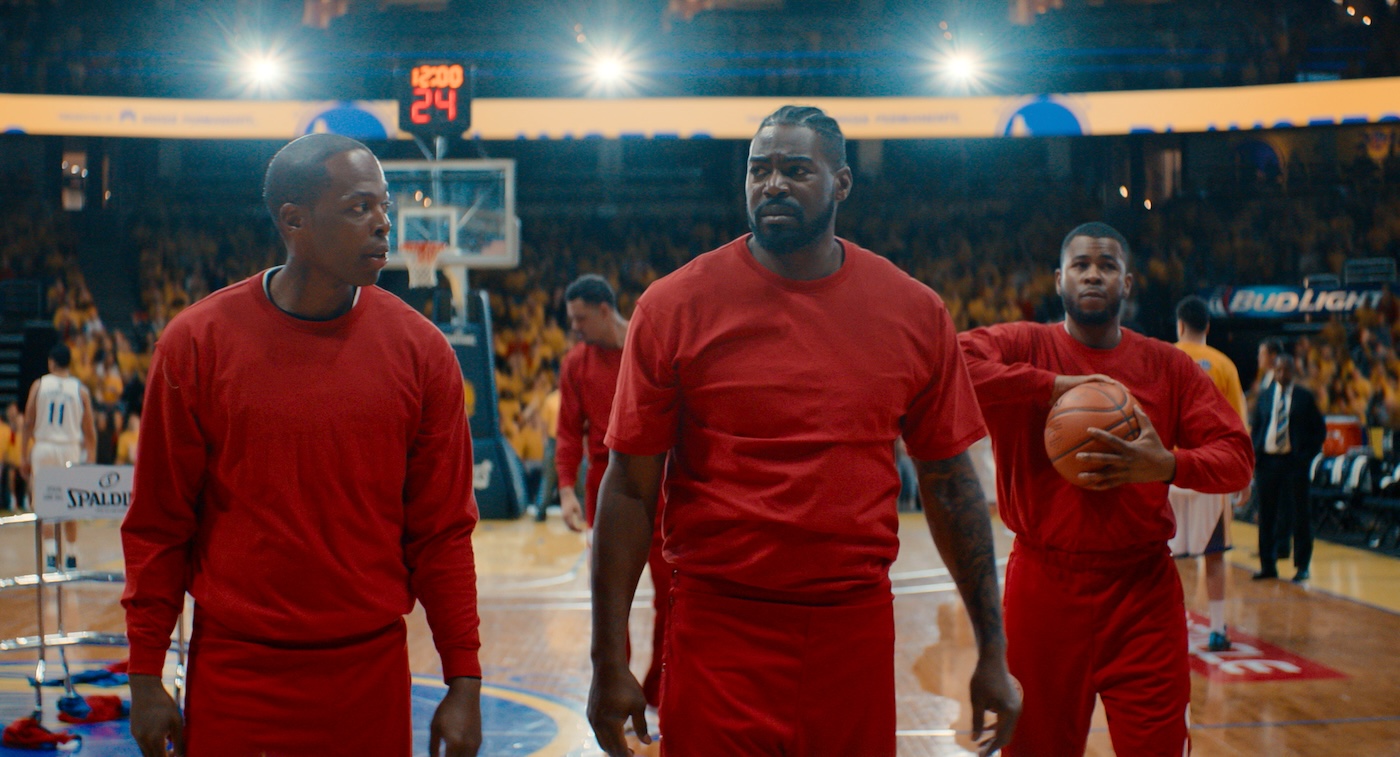
Episode 3 also sets off a tonal shift toward a dark side – Doc and the players grappling with the scandal – and a glossier side – V. trying to capitalize on the massive media attention the leaked tapes generate. Furmanski [ICG Magazine September 2020] notes that “Kevin and Bryce beautifully set the stage for meeting all these different characters and providing examples of what kind of person Donald Sterling is. In episode three [directed by Francesca Gregorini] we see how [Sterling’s words and actions] are affecting everyone – not just as a basketball player, coach, or spouse, but as a human being. It brought up questions for the characters like ‘What do we stand for?’ which is a key part of the series.”
One such example is a long dialogue scene, set in a San Francisco hotel ballroom and shot at the Four Seasons in L.A., that may be one of the most frank conversations about race in America ever portrayed in a fictional series. “That scene, and many others in episode three, were a lot about people talking everything through,” Furmanski continues. “We thought it was important to keep those scenes visually alive, so it didn’t feel like we had hit a brick wall of exposition. Using basketball terminology, we lit the team meeting with a ‘zone system’ instead of ‘man-to-man,’ to be true to the actors’ process. Although the actual space was massive, they’re all clustered around a few tables in the corner, so we let the room go mostly dark and just lit the conversation.”
The discussion plays out in quasi-real time as each of the Clippers – stars and role-players alike – openly express their feelings about a league rife with caste-like racism. Chief Lighting Technician Kiva Knight says for those scenes, the electric and rigging teams capitalized on the low-light sensitivity of the ALEXA Mini LF to “get into those dark places and not have to light very much from the floor.” Knight credits Set Lighting Technician Drew Nelson for filling in on days he was out with illness (including the player team meeting scene in the S.F. ballroom) as well as other key members of the electric and rigging crews, including Rigging Gaffer Hector Corona, Best Boy Mark Hartman and Lighting Programmer Zach Perez, “for doing a lot of heavy lifting, which seems typical of so many of the shows I work on,” Knight laughs.
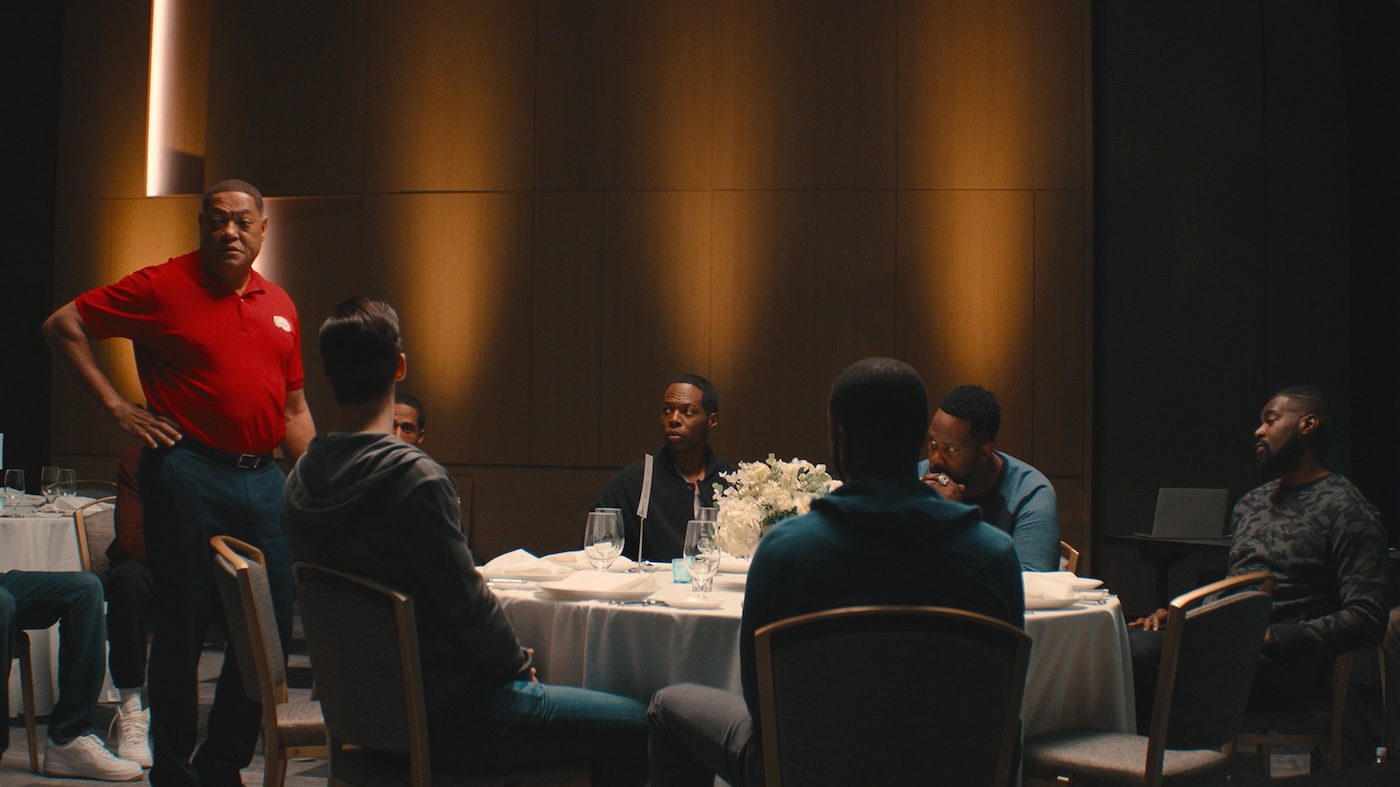
Clipped offers many similarly dark scenes that create a distinctly cinematic look. They include Episode 4, where former Clippers general manager Elgin Baylor (Clifton Davis) dribbles a basketball through the darkened office hallways after deciding he will sue the NBA; Episode 3, where Sterling’s right-hand man, Andy Roeser (Kelly AuCoin), sits alone in his darkened office listening to the V./Donald tape as a maintenance crew member pauses his work to watch the tape on his smartphone; Episode 6, when Doc Rivers passes balls to Baylor, who is shooting alone in an empty Staples Center steeped in shadow; and Episode 3, when Doc walks through the bowels of Oracle Arena on his way to the team bus, now fully cognizant of what the V./Donald tape will mean for his players.
“That scene of Doc walking out to the bus was a great marriage of what Bryce and Kevin had introduced in episode two, and this move toward a darker overall tone,” Furmanski describes. “From a lighting perspective, I may not have gone as dark and moody as we did, if not for this new dramatic tone with Doc – and all the characters – who, as soon as the tape goes public, are living under this media microscope. The shot of Doc in episode three, much like a shot in episode five we did when V. arrives for the Barbara Walters interview, is high above and looking down. It’s like these people are in a fishbowl, and we are watching their every step.”
Knight adds, “Working at the very low end of the [lighting] spectrum is where I feel most comfortable, so it was great to work with two cinematographers who are not afraid of the dark, in any way. That’s no small thing, as I’m encountering more DP’s who don’t have the knowledge earned from when we had to light for film. Usually, that means me bringing everything I have off the truck and helping the DP find the [lighting style] on the day. It’s so great to work with [DP’s] like Bryce or Jonathan, who are so clued-in to what they want to do. The same holds for everything I’ve done with [Director] Barry [Jenkins] and [Director of Photography] James [Laxton]. When I land on set, James hands me a bible, and we walk the hallways of the art department. Then we start testing the tools we will use on the day. On Underground Railroad, those tests were so extensive, they used some of the shots from tests in the final.”
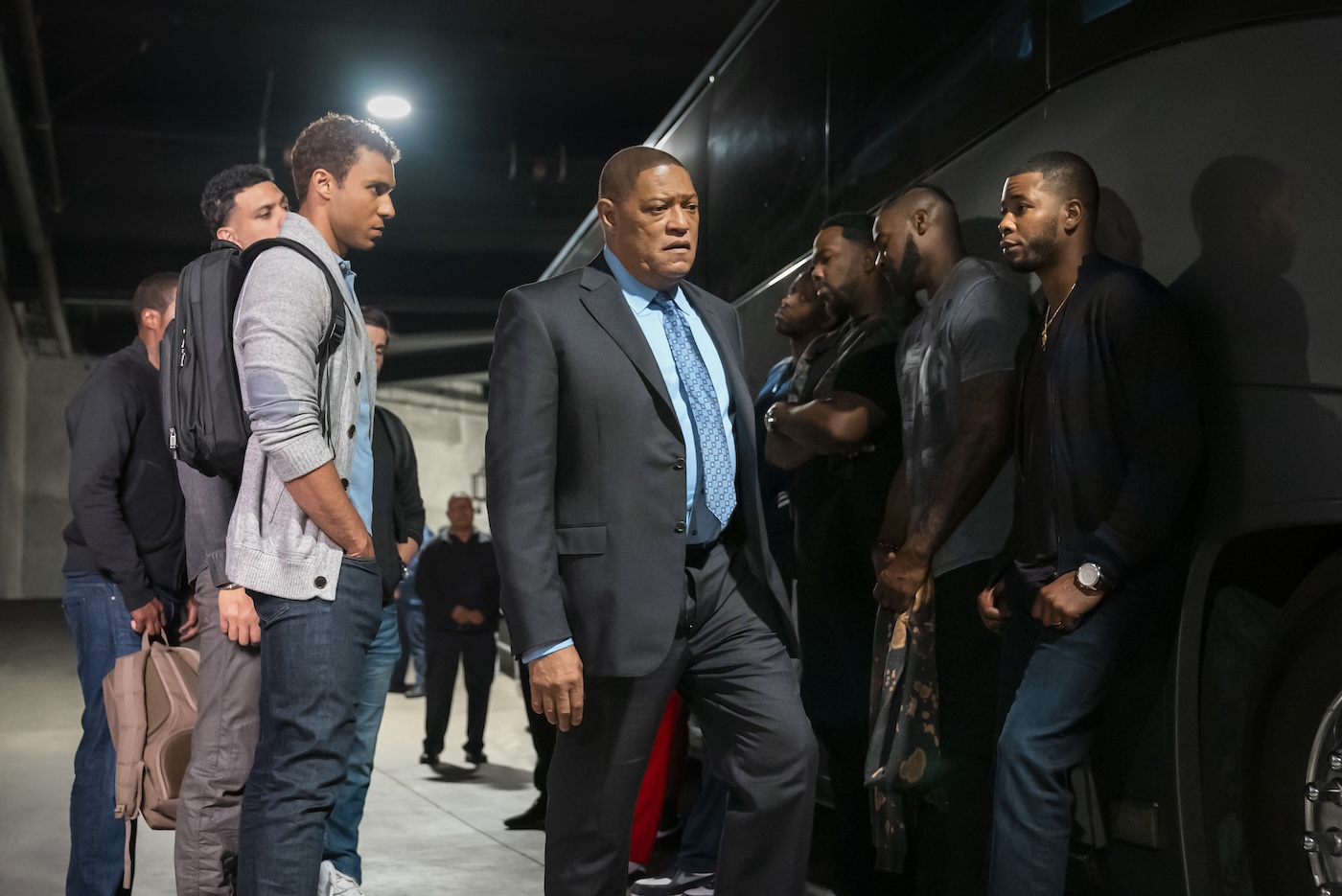
Episode 3 also features a visual shift in V.’s world as she assembles a PR team to help push her newfound fame. That includes two scenes (taken from real life) in which V. rollerblades through a phalanx of paparazzi outside her duplex with a reflective visor obscuring her face, and another at night where she frees a turtle on her lawn while dressed in S&M chic. “I remember a lot of conversations about the rollerblading scene, and being true to the real event,” Furmanski recalls. “The turtle scene was already so strange in real life it didn’t need any dressing up or enhancement from camera.” Also ripped from reality are one-on-one Barbara Walters interviews Furmanski shot in Episode 5, including V. Stiviano and Shelly Sterling. “Those interviews were iconic, so we had to, minimally, be true to what Barbara Walters’ cameras were capturing,” Furmanski adds. “We sourced a Sony EX3, which was considered a high-end video camera at that time, and were careful to try and duplicate the backgrounds for the eyelines.”
Furmanski says he remembers “how oddly placed” the real cameras were for Shelly’s interview. “They were at a three-quarter angle so you couldn’t see Barbara and Shelly straight on. So, at least for the network cameras, we tried to be faithful to whatever they were trying to achieve. With our ALEXA cameras, we were free to pursue a peeking, paparazzi approach, behind all the light stands and gear the network would have used, and what Bryce and Kevin had established.”
The episode also includes an iconic press conference by NBA Commissioner Adam Silver announcing Donald Sterling’s “ban for life” from the league and a directive to ensure the Clippers are sold to new ownership. “The real-life backdrop for that press conference is massive,” Furmanski continues, “and, unlike the Barbara Walters interviews, we did not have the resources to build out what the NBA had. The question then became, ‘If we can’t mirror 50 different news cameras lined up, and hundreds of reporters in the room, how do we still get the feeling of this media circus?’ One solution was to use constant light flares into the lens to create this impression of intense activity. We used the requisite amount of set dressing and extras to convey the moment, and then let the deep background fall off.”


With no 4K deliverable, Fortner says he was primed to shoot the series on the ALEXA Mini. “I feel like large format has become this look everyone is defaulting to,” he shares. “But since Kevin likes to do a pass at the end of each scene at 60 frames per second, our DIT [Pasquale Paolo] said it was better to use the Mini LF. So we went with that camera and cropped for Super 35 millimeter.”
The Guild camera team tested vintage and modern anamorphic and spherical lenses. As Fortner adds: “Since Kevin wanted a 16-by-9 image that would fill the screen, Jonathan suggested using the Hawk Anamorphic 1.3× at full frame, and it was quickly apparent this was the way to go. The Hawk 1.3’s have all the perks of anamorphic – barrel distortion, flares, elliptical bokeh – but they also have an extended depth of field so they don’t scream ‘anamorphic.’ They feel more like vintage spherical lenses. We also used some anamorphic zooms, as I love using a slow servo zoom or pan to find a moment in a scene – like in episode six when Donald is testifying in court [and talking about how the NBA has ‘mesmerized’ Shelly into selling the team to get the league off the hook]. John Seale [ASC, ACS] was a master of using zooms – and blocking – to create a wide shot that comes into an over and oner. That stuff is super fun to do.”
Episode 4 (shot by Fortner and directed by Bray) follows the public revelation of Sterling’s racism and details the personal histories of the main characters leading up to the scandal. We see a young Doc Rivers playing for the Clippers in 1992, as L.A. erupts with social unrest after the Rodney King trial. We see V. running a food truck on a studio lot and meeting “Deja” (Yvonna Pearson), who becomes her close friend during the scandal, as well as Andy Roeser telling Baylor of his reduced place in the organization, which inspires the legendary Laker’s lawsuit against the NBA.
Finding the episode’s look came through a risky choice by Fortner and Bray to use a 16-millimeter spherical zoom lens on the Mini LF (rated at 3200 ISO) with the necessary crop to ensure there was no vignetting on the 16-millimeter zoom. To visualize a flashback (2014) within a flashback (1992), with another actor (Freddie L. Fleming) portraying Doc Rivers, Bray says, “We wanted to create a patina that immediately put you into another temporal space. We used handheld throughout in a freeform Laws of Gravity kind of way. It was probably the one time in the series we got away from that observational, fly-on-the-wall and went with a more subjective point of view. We had to see the L.A. riots [on a TV in an upscale white neighborhood] through young Doc’s eyes; we needed to see the Sanctuary party [where the guests are all having sex and V. meets the owner of the house] through V.’s eyes.”

Bray says they tried to make the Sanctuary location look “like a labyrinth as V. goes from room to room and discovers what’s going on – like an Alice in Wonderland kind of scary space. But everything was boarding out much longer than we had time to shoot. Fortunately, Bryce is so good at keeping things simple, I just let him run with that location.” Knight recalls the key to lighting the Sanctuary party was “walking through each room to identify the color palette. Between the wild costumes and all the guests being masked, the location was sort of a license to kill, lighting-wise,” Knight smiles. “We used LED tubes and practicals throughout the house, replaced bulbs as needed for color shifts, then when V. is outside, we utilized our ‘garden package,’ which meant a lot of LED PARs.”
Vertovec says the Sanctuary scene featured “full blue, full red concert-type lighting with exposed filaments in the shot. Back then those lights would not have been LED [even if Knight’s team used LEDs on set]. They would have been gelled fluorescents or something like that. So, the challenge when doing an HDR final grade is not to let those colors pop so much they distract from the action. In that example, I’m rolling the highlights down more than usual and making sure we don’t introduce too much chroma noise, which would make everything look out-of-kilter.”
As Fortner recalls about his campaign for Episode 4’s unique look: “We were going to deliver FX a 1.7K image, which is barely HD. So they were rightly concerned about how radically different this would look from the rest of the show. Gina asked if we could do the look in post, and while that certainly was doable, I explained it’s a whole different thing when you’re seeing the look in real-time. We’re using a 16mm Canon ENG zoom, at 3200 ISO, which creates this grainy, imperfect image with weird bokeh, and that dictates different creative choices on the day. The concession was to keep the same LUT as the rest of the show but shoot it in this very different style and feel.”
Vertovec says Fortner came onto Clipped with a show LUT he had used over many projects, one that was predictable and allowed him to work very quickly, with minimal time spent in Video Village. “That was great,” the colorist adds. “But it was going to have to be rebuilt at some point for the HDR finish, which we did together. Bryce and I talked about the grain in episode four – he’s pushing the sensor and cropping for the 16-millimeter zoom – and we decided to just leave it alone. It’s noisy and dirty, but so are many TV shows from the early 1990s, which were shot on 16 millimeters. Shooting 16-millimeter film is way grainier than anything you’d capture digitally, so our approach was just to leave all the grain in until someone told us to take it out. And they never did! [Laughs.]”
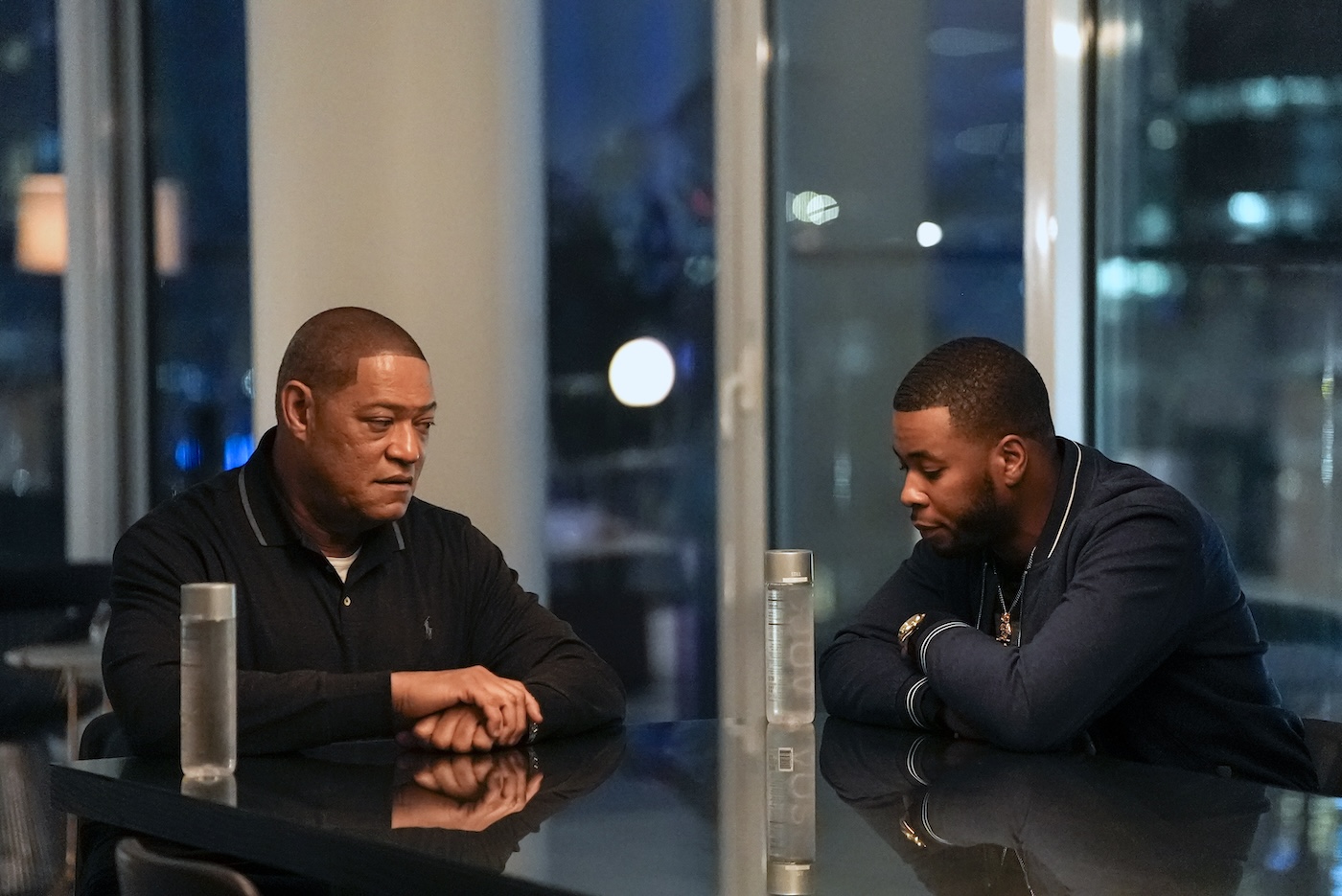
In a series filled with eye-popping location work – the Sterling mansion high above the Pacific, the rain-slicked Hollywood streets at night, the wood-paneled L.A. courtroom filled with warm practicals (where Donald blows up at Shelly while she is testifying) – the sheer scale of Doc Rivers’ downtown L.A. condo soars above the rest. As Welch recounts: “In my research for the story, I had spoken to Doc about the first condo he lived in in L.A. – before he bought a house – and it was this massive space overlooking a golf course. But we found out you cannot shoot in those condos on Wilshire Boulevard. So, the next best thing was this huge space, with floor-to-ceiling windows and the downtown skyline. The main thing we wanted to convey was that here was this man with wealth, fame, and celebrity, who is completely alone. What you get is that he is all in to win a championship with this franchise, this year. In the solitude of that huge space, you get Doc’s single-mindedness.”
The location features prominently in Episode 5 (shot by Furmanski) and the final episode (shot by Fortner). Episode 5 features Doc alone at night fielding phone calls before Adam Silver’s press conference announcing Sterling’s fate. The lights of downtown reflected through and off the huge windows, flare into the lens as the camera retreats to another high-down shot to provide scale for Doc’s nocturnal isolation. Later, Chris Paul visits to relay the temperature of the other Clippers players (as well as their playoff opponent, the Warriors), who all want to boycott the next game. Because Fortner had shot there in Episodes 1 and 2, Furmanski says the camera, grip, and electric team were already familiar with the challenges of the location. “Number one in my mind,” Furmanski shares, “was shooting at night with those floor-to-ceiling windows and the inability to rig lights from the ceiling. Staging played an important part as we were smart about not sending actors off toward the corners in darkness. Also, Kiva’s team was very clever about hiding lights from the floor wherever they could.”
Knight says “Doc’s condo scenes were a high point for me, as it was such a pleasure to see Laurence Fishburne in action. Great crew guy, and a great mentor to younger actors and filmmakers. As for lighting that space, we just kept moving practicals around as best we could. Anything that could handle bigger incandescents, we went that route, and for anything small, we swapped out with LED bulbs. Looking across the kitchen table, there was an array of nice lamps that we made good use of. Between the ambient exterior light, and the lamps inside, even if you don’t have a lot of light on the actors, they’re still getting picked out by the silhouette of the lamp or a building on the skyline.”
A rooftop scene in Episode 5 features Doc calling Adam Silver to ask for help in handling the oncoming media tornado. Both Furmanski and Knight said that while spectacular in its final execution, the scene was subject to larger forces. “A new building had gone up just a few months before we shot that blocked a direct line of sight to Staples Center from the roof,” Furmanski laments. “I think the scene plays great. But having Staples Center in the background would have been the cherry on top.” Knight says that although “the blocking for the rooftop scene was tough, with Doc right up against the railing, and only the city light behind him, I fault myself for not figuring out a more simple way to light a guy making a phone call on a roof at night,” he laughs. “It felt like pulling teeth for my team to get it right, while it should have been one of the easier shots in the whole show.”
Furmanski recalls Knight’s team placing some Lustre Lights into the pool “to get some watery reflections, and one four-foot Astera tube to provide some fill onto Doc when he’s making the phone call. Shooting at such a high ASA, exposure was never a problem on this show,” the DP recalls. “The rooftop scene was almost the opposite situation as the ambient light from the city was so strong, Ian had to bring it [and the grain] down a little in the DI so it didn’t feel like there was almost daylight.”
Episode 6 returns to Doc’s condo to explore an ongoing relationship the coach has formed with actor LeVar Burton (playing himself) after meeting in the building’s sauna. The men confide in each other about racist events in their past that, they admit, still inform their behaviors today. “[Director] Michael Blieden and I had planned a big walk-and-talk on the terrace, and pre-lit for that,” Fortner remembers. “But when we got there, the weather was way too cold, so we had to quickly pivot. I told Michael that as we had about two hours to shoot, it would have to all be inside with practicals. It turned out to be one of the scenes I’m most proud of in the whole show. Surprisingly, it was more about taking light away than adding. I’ve been pushing the ALEXA with each show, and while I used to be terrified to go to 1280, I’m now shooting everything at 3200, and I love the texture. It’s a rebellion of sorts to what I feel as everything looking way too perfect these days.”
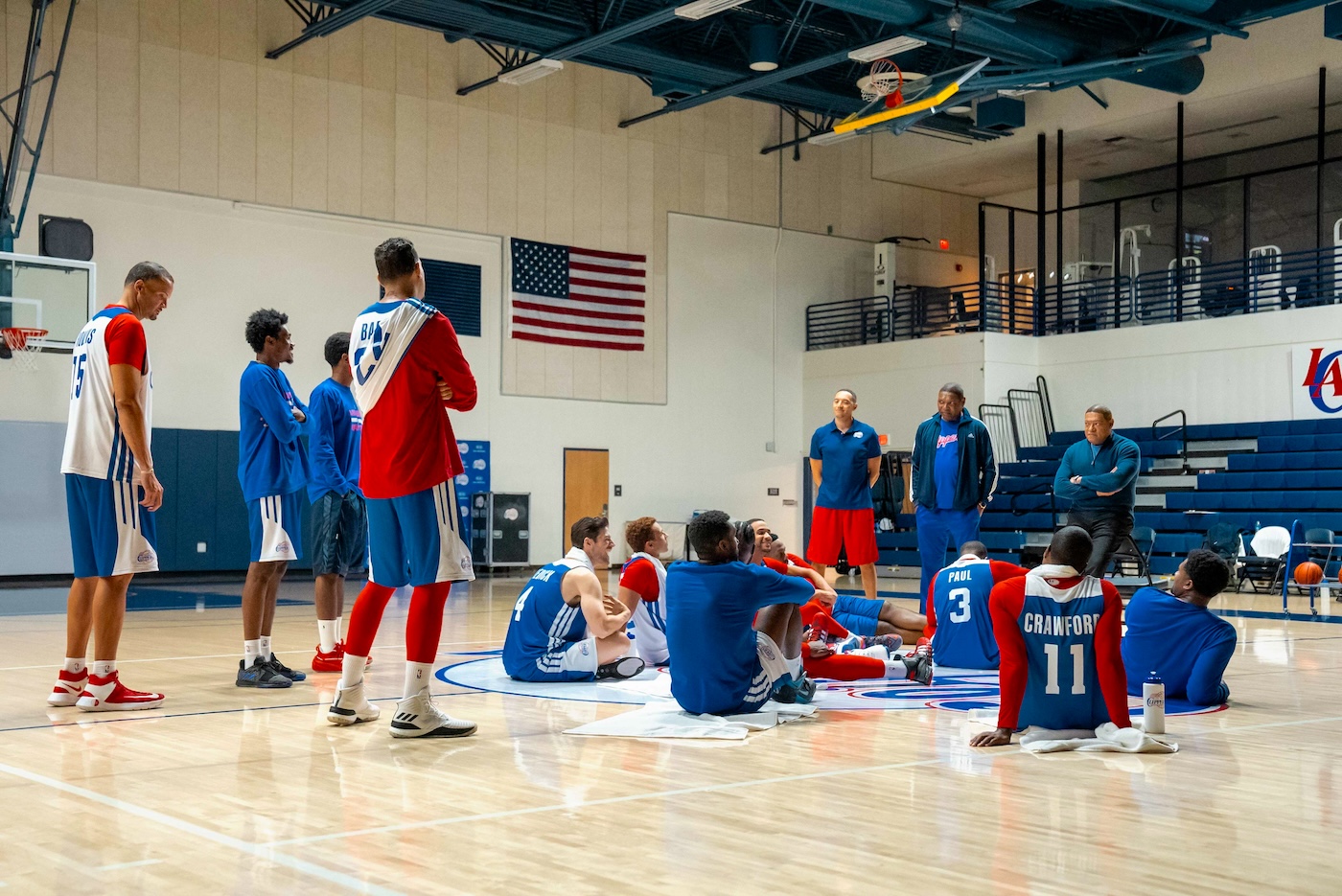
While Clipped is set in the world of professional basketball, the on-court action (most of it shot at the Honda Center in Anaheim, CA) is secondary to the larger themes of race, power, and gender subjugation. But since these are the world’s best athletes, their craft needed to be seen. Fortner says casting was a big part of the on-court footage. “Finding actors who looked like the real players, are athletic, and can play basketball is no easy feat,” he describes. “They had to be able to run some of the same plays from the [Clippers-Warriors playoff series] many times. Kevin had the brilliant idea to lay dolly track the length of one side of the court, with a 12-to-1 spherical zoom, and then another zoom higher up in the arena. This way the operator on the dolly could track with the players and find different moments with the zoom. It’s a very different approach than Winning Time [ICG Magazine April 2022], where you’re literally in the action. We were removed and composed, which lent a more cinematic look.”
Fortner says Bray was adamant about not using green screen to fill the arena. “Barnstorm VFX, who did crowd work for Ted Lasso, used a process called ‘crowd sprites,’” Fortner explains, “where hundreds of background actors are shot individually from multiple positions and perspectives and then tracked into the arena. I remember the background just falling off into black with no tracking marks or green screen, and thinking: ‘How is this going work?’ And then you see the comped scenes and the arena looks full. But there was nothing there – at all.”
Local 600 Director of Photography Jason Oldak (who had never shot basketball) had worked with Bray and many members of the camera, grip, and electric teams. He says, “We loved what the ICG crew over at Winning Time had achieved with their basketball footage, but this was not that show. The basketball scenes needed to pair well with the dramatic tone, but never overpower it by putting the camera in places where it would feel like we were forcing in a visual style.”
Basketball coordinator Justin Skinner was brought in to design the placement for each player and how a scene would happen based on the real playoff sequences being referenced. “Justin recorded the play-by-play for us all to see,” Oldak continues, “and this helped with the shot design breakdown, and referencing to see how NBA athletes were moving through those real-life moments.” Oldak says he and Bray watched Skinner’s filming to analyze who was important to feature. “We would then discuss the points we needed to make and where the camera needed to be, creating a shot list for the week,” Oldak adds. “We carried three cameras for all of the arena work. We would pair our coverage from outside the foul lines with specific moments where we would bring the cameras onto the court for coverage. We created a three-camera setup exactly how the Clippers’ playoff games were shot in 2014 for broadcast, so the production could use that footage on televisions if they were to cut to a scene with the game on in the background.”
Oldak says he referenced how Staples Center would light the Clippers’ court and stands, “which was quite different from [that of] the Lakers, who play in the same building,” he continues. “Working alongside our rigging team, we spoke with facilities and our dimmer-board operator, to figure out how to turn on and off the [LED] Musco lights above to create some shape for our actors when we were shooting from one side of the court. Kiva’s team placed rock ’n’ roll lights mid-level for when the players were announced at the beginning of one of the playoff games and also for some edge and flare when needed. They used a mix of the facility’s lights and our own, with a few units on the ground to shape our actors.”
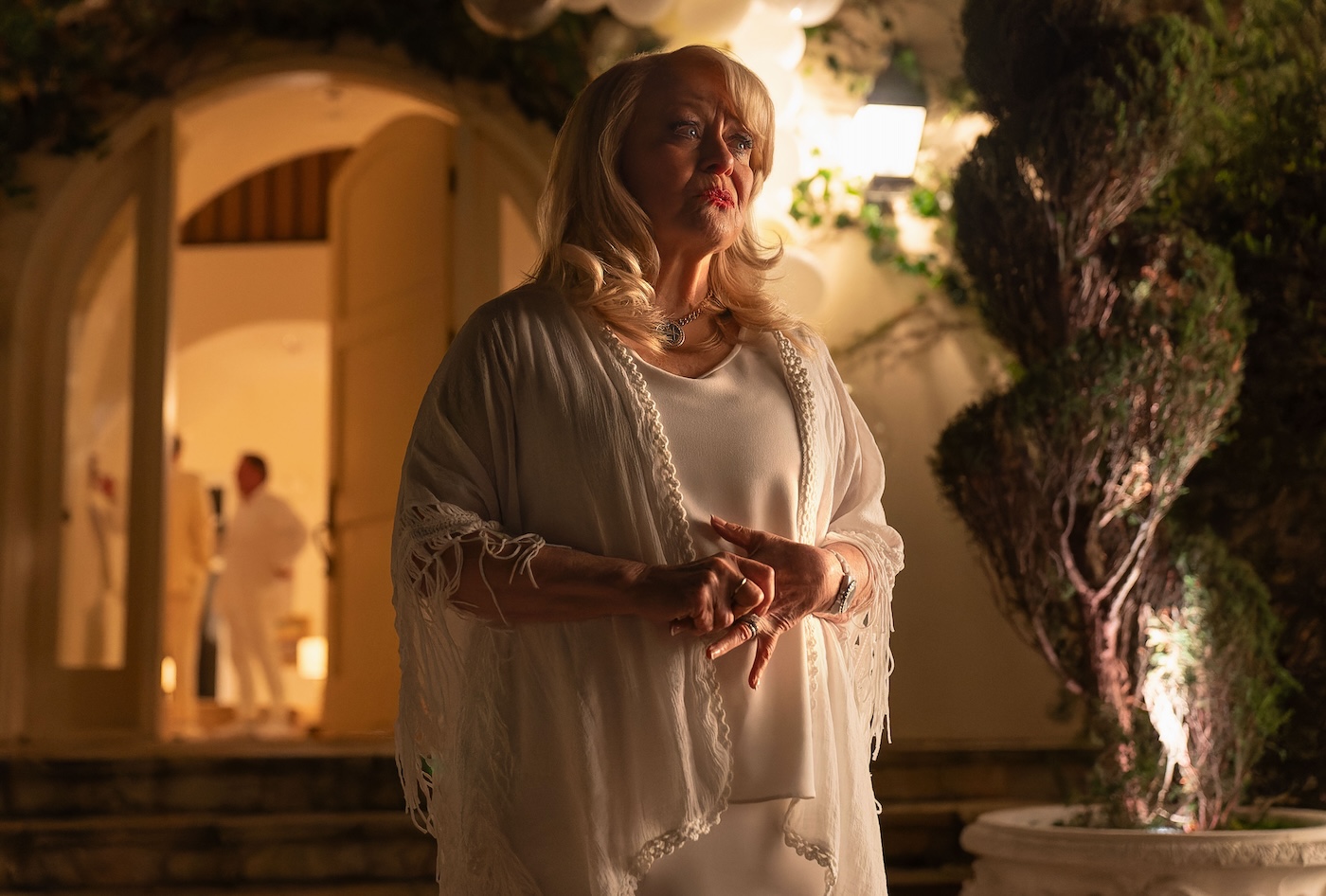

Reflecting on the series as a whole, Welch notes that “it was challenging, structurally, to make a series out of a podcast, because the show needed to be about these two colliding narratives. The story of Doc Rivers and the team crashing into this chaotic domestic triangle. But in terms of story-per-pound, there was more going on in the Sterling-V. side of the ledger, in the aftermath of that season. So the puzzle was trying to figure out how to keep those two narratives alive, even though their timelines are slightly different, as well as investing in the humanity of this large ensemble of characters.”
Vertovec says the relationship between Welch and Fortner was the key to the look and feel of the show. “Except for episode four, which Bryce did remotely, he and Gina were in the DI together,” the colorist recalls, “and I could see the tremendous appreciation she had for Bryce as a filmmaker. She trusted Bryce’s vision and relied heavily on him for the look of the show. One of the harder parts of the DI for me was dropping in the social media crawls with Bryce and Jonathan’s photography so [that] it didn’t just feel like a white card, particularly in HDR. Gina had a sharp eye for how viewers should pick up what they’re seeing on Instagram or Twitter, yet not completely disrupt the look of the show.”
Welch, who had never worked directly with a DP before Clipped, says she had staffed on other showrunner’s shows, “and they had worked with some great DP’s. But I had not,” she concludes. “I knew Bryce was talented, but I didn’t realize how much he elevated the show until we were in the DI and saw how carefully curated he’d been with the color palette. The red in Shelly’s lipstick matched the red in V.’s Ferrari, which matched the red roses, which matched the red Clippers uniform. The color story we were telling was largely red, white, and blue, with pops of green for V., and I thought, ‘Wow.’ Bryce, independently, had been protecting how this entire series coheres with the look. If I could work with him for every show moving forward, I would not be unhappy [laughs].”
Local 600 Camera Team – Clipped
Directors of Photography: Bryce Fortner (Ep. 1, 2, 4, 6); Jonathan Furmanski (Ep. 3, 5)
Additional Director of Photography: Jason Oldak (Arena Work)
A-Camera/ Steadicam Operator: Kenny Niernberg
B-Camera Opeartor: Ryan Hogue
A-Camera 1st AC: Samahra Little
B-Camera 1st AC: Cameron Wakayama Carey
A-Camera 2nd AC: Rodrigo Melgarejo
B-Camera 2nd AC: Lane Clark
Loader: Rose Licavoli
Digital Utility: Gustavo Medina
DIT: Pasquale Paolo
Additional DIT: Max Weckbaugh
Unit Still Photographer: Kelsey McNeal
